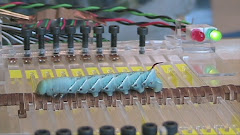
From my caterpillar GRF data, I discovered that in almost any instance the substrate is stretching the animal axially. I was intrigued by the idea that such a soft-bodied animal might be actually "depending" on the substrate stiffness to achieve neccessary deformation during locomotion. So, I thought maybe the stiffness of the substrate would affect the crawling performance in a very predictive way. The first test that came to my mind was to suspend the animal from the head capsule and the rear horn (see photos). By feeding the animal different substrates, they could "walk the substrate backward" by doing their normal forward locomotion in my suspension setup. Interestingly, they crawl just fine with a balsa wood. As I reduced the stiffness of the substrate by changing from wood to rubber and eventually to a soft wire, the caterpillar started to buckle the substrate and failed to produce the stereotypic locomotion pattern. This is the first behaviroal support for the "environmental skeleton hypothesis".

 From my caterpillar GRF data, I discovered that in almost any instance the substrate is stretching the animal axially. I was intrigued by the idea that such a soft-bodied animal might be actually "depending" on the substrate stiffness to achieve neccessary deformation during locomotion. So, I thought maybe the stiffness of the substrate would affect the crawling performance in a very predictive way. The first test that came to my mind was to suspend the animal from the head capsule and the rear horn (see photos). By feeding the animal different substrates, they could "walk the substrate backward" by doing their normal forward locomotion in my suspension setup. Interestingly, they crawl just fine with a balsa wood. As I reduced the stiffness of the substrate by changing from wood to rubber and eventually to a soft wire, the caterpillar started to buckle the substrate and failed to produce the stereotypic locomotion pattern. This is the first behaviroal support for the "environmental skeleton hypothesis".
From my caterpillar GRF data, I discovered that in almost any instance the substrate is stretching the animal axially. I was intrigued by the idea that such a soft-bodied animal might be actually "depending" on the substrate stiffness to achieve neccessary deformation during locomotion. So, I thought maybe the stiffness of the substrate would affect the crawling performance in a very predictive way. The first test that came to my mind was to suspend the animal from the head capsule and the rear horn (see photos). By feeding the animal different substrates, they could "walk the substrate backward" by doing their normal forward locomotion in my suspension setup. Interestingly, they crawl just fine with a balsa wood. As I reduced the stiffness of the substrate by changing from wood to rubber and eventually to a soft wire, the caterpillar started to buckle the substrate and failed to produce the stereotypic locomotion pattern. This is the first behaviroal support for the "environmental skeleton hypothesis".

.jpg)